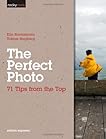 The Perfect Photo: 71 Tips from the Top by Elin Rantakrans
The Perfect Photo: 71 Tips from the Top by Elin RantakransMy rating: 2 of 5 stars
Obviously, The Perfect Photo is mis-named. At a mere 128 pages, this is a pocket book and it is not attempting to be the modern day counterpart of Ansel Adams series on photography or Photography by London and Upton. But what is it? It purports to be a set of simple tips for any photographer, regardless of equipment. However, while the tips are indeed the classic ones that every photographer needs to learn, this book is harder to use for the beginner than it needed to be. It tries to be all things to all people, but it is not enough for a knowledgable photographer, and it skips information that a novice would need to be able to use the good advice effectively. So it fails to deliver to anyone.
The format of The Perfect Photo is similar to what other photographers who are also columnist have used, a set of short articles each on a single subject organized topically. The problem is that while the book is probably best for novices who have not learned these methods, the articles are aimed at photographers with a particular type of equipment, Full Framed system cameras, which are the high end of photography equipment. For example, many of the chapters discuss the use of features that would not exist on point and shoots or compact cameras such as white balancing or the manual controls for aperature and shutter speed. And it does not discuss the work arounds that those who have gotten good at working with these types of cameras have developed to compensate.
More egregarious are the issues with sensor size. While everything they discuss is in terms of Full Frame sensors (24 x 35 mm), they acknowledge something called a half-frame camera. But there is nothing marketed as 'half-frame camera'. There are the digital cameras with APS-C sensors (ranging from 13.8 x 20.7 mm to 19.1 x 28.8 mm depending on manufacturer), there is the four-thirds system, (17.3 x 13 mm) and a few other proprietary formats that are used by a single manufacturer. But none of those is 17.5 x 24 mm , which is presumably what half-frame would be. And while it does mention a few equivalent focal lengths (e.g. that a 50 mm lens will cover the same area on a 'half-frame sensor' as a 75 mm lens on a full-frame camera), they don't go the obvious next step of saying that you can multiply by a factor of approximately 1.5. Even this discussion is not until Tip 22. So in multiple discussions of lens focal length, the novice would not have noticed that there was an issue and they needed to mentally adjust the discussions of what wide-angle, normal or tele-photo are.
And this is my complaint about this. Each tip is oriented towards the novice photographer who is just getting serious and needs to start somewhere. But the individual essays almost require a base of knowledge of photography and the workings of the equipment to understand it fill in the missing details. And worse, the novice would not have realized there was a problem until she tried to use the tip.
Rocky Nook (publisher) offerings seem to be finding replacements for the teaching of photography technique that are useful for the digital age. And this book seems like it was to meant to be the slim fieldbook for the novice who is just starting the road to being serious. But while each tip is good in itself, it needed an editor's hand to pick its audience and focus on it to properly fill this niche.
Disclaimer: I received a free electronic copy of The Perfect Photo as part of the O'Reilly Bloggers program.
View all my reviews
No comments:
Post a Comment